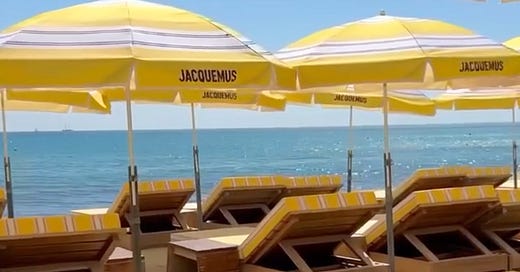Fashion Isn’t Scaling Stores. It’s Rewriting the Real Estate Strategy.
What 2025 luxury brand behavior tells brokers, developers, and investors about what’s next.
This week on The Laureate Edit, we’re looking at how luxury brands and top-tier hospitality operators are quietly rewriting the rules of physical space and what that means for the future of leasing, layout, and asset strategy across commercial real estate.
Let’s dive in!
If Loewe wants 1,500 SF and your floorplate is 20,000, what’s your plan?
Luxury brands aren’t stepping back from real estate. They’re just getting more selective:
faster cycles
smaller footprints
higher expectations.
The best in the business are using space with a level of control and clarity that should make any landlord or investor pay attention. Not because it’s fashionable, but because it’s working.
⸻
What They’re Doing Now
1. Short leases, strong outcomes
In Q1 2025:
• Jacquemus launched a 45-day activation in Venice Beach under 1,200 SF
• Bottega installed a temporary campaign studio in Aspen
• Loewe took over a converted home in Savannah for a 3-week drop
These activations display a masterclass in being lean, strategic, and efficient. And done before most landlords would’ve finalized a LOI.
2. Hospitality takeovers
Louis Vuitton booked a branded suite at Cheval Blanc live during Fashion Week only. No storefront. No permanent staff. All high-touch, low-friction conversion. Prada hosted its top clients inside a private residence in Miami during Art Basel. Quiet rollout. Full schedule. No risk.
3. Flex as brand infrastructure
Brands are using small-scale flex spaces for:
• Private client services
• Campaign content
• Stylist previews
These spaces don’t need traffic. They need control. And, these smaller footprints, achieve just that.
Where Hospitality is Headed: Off-Premises is On Strategy
A new report from Revenue Management Solutions confirms what high-end operators are already living: off-premises dining isn’t a pivot, it’s permanent infrastructure.
• 46% of consumers now expect delivery or takeout as a baseline
• 60%+ of operators say it’s essential to business viability
This shift isn’t limited to fast casual. High-end restaurants are adapting, too rethinking how they use real estate in the process.

What this means for CRE:
• Dining rooms are shrinking. Back-of-house space is being prioritized for outbound service, logistics, and packaging control.
• Experience can now be exported. Tasting menus are being reengineered for delivery. Brand value is traveling further without needing extra tables.
• Buildings need to do more. Curbs, valet zones, and alternate pickup access points are becoming leasing differentiators, not operational afterthoughts.
If your restaurant space only supports traditional sit-down models, it may not meet the expectations of the next generation of top-tier operators.

What CRE Should Be Thinking About
For Brokers:
• Position short-cycle activations as value-adders, not fill-ins
• Pair them with surrounding tenancy to show asset momentum
• Prep deal decks with 90-day, 6-month, and 1-year tiered options
For Developers:
• Program ground floors with rotation in mind
• Create leasing kits for turnkey pop-ups and campaign spaces
• Build suites that flex between short-term retail, private dining, and media use
For Investors:
• Track space utilization, not just term length
• Model activation-based returns in dense markets where visibility compounds
• Watch how lifestyle submarkets are monetizing velocity over duration
⸻
Why It Matters
This isn’t about trends in fashion or food. It’s about the decisions smart operators are making when they look at their P&Ls and how those decisions are showing up in the spaces they choose, how long they stay, and what they expect from the built environment.
Luxury brands and elevated hospitality groups aren’t retreating from physical real estate they’re just rebalancing how they use it. They’re trimming square footage, tightening timelines, and demanding spaces that flex with the speed of their business cycles. They’re still willing to pay for the right location, but only if the format matches the function.
For brokers, this means rethinking what a “fully leased” win looks like. For developers, it means designing with modularity, multi-use, and pace in mind. For investors, it means measuring value not just by length of term, but by how many ways a space can perform.
As off-premises dining becomes an expectation and pop-up retail proves its profitability, one thing is clear: the assets that win next won’t just be beautiful. They’ll be nimble, frictionless, and programmable.
If your space can’t adapt, someone else’s will.




